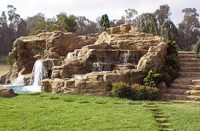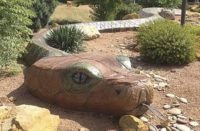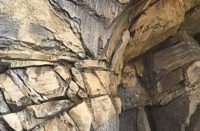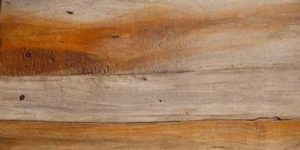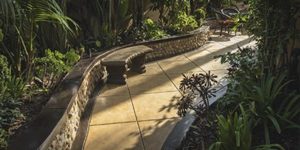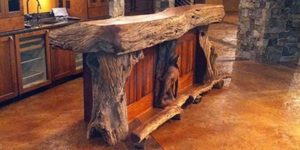
For a man who was an Eastern Airline employee for years and owned his own pest control company after that, he found working with his hands, LEDs and chemicals familiar territory. So when the economy began to tank, it wasn’t that far of a stretch when Clem Carrion founded Visual Artisan in December 2007, a concrete business that specializes in concrete countertops, innovative lighting and metallic epoxies, as well as faux wood and stone.
Carrion was a self-starter who practiced at home after taking some courses at JPJ Technologies in Sheridan, Oregon, on how to make rocks, waterfalls and boulders out of concrete. His work in his own backyard grew his clientele from word of mouth and friends who saw his projects and wanted them in their homes, too.
That’s when Carrion decided to focus on renovating homes, but he wanted to do something that set him apart from others in the industry.
On one of his jobs that involved rehabbing a condo in downtown Orlando, Carrion proposed to make a water feature lit with LEDs out of existing columns in the middle of the living room. The client, who wanted a feature that would stand out, loved the idea. It was his first paid LED and concrete gig and it ultimately helped build his client base, he says.
“I noticed that bars and restaurants wanted unique floors and countertops, too, so that’s when I got into that,” says Carrion.
With a continuous thirst for knowledge, Carrion sought out training and took a class on faux finishing for floors and countertops by Faux Effects. That slowly opened the door to the world of epoxy.
“I believe that even though I have some knowledge, if I walk away with one thing that I didn’t know then I can just get better,” says Carrion about the benefit of training classes.
No (visible) strings attached
For a man who likes to learn and think outside of the box, there was no limit to what he could do and he began creating things that had “the wow factor.” He recalls walking into a restaurant or hotel and envisioning how he could incorporate LEDs without the wiring being visible.
“With concrete I’m thinking, OK, how can I put in LEDs or fiber optics?” says Carrion, noting that there’s so much opportunity for creative contractors to combine concrete with lighting. “One thing led to another and I started exploring that topic. Now I teach other individuals how to add fiber optics to their concrete.” He uses both fiber optics and LEDs in concrete, he says, and when clients request lighting, most want both.
Another “wow factor” Carrion likes to incorporate into his projects is real copper powder, which he often includes in his concrete sinks. While it’s not hard to work with, it does involve more steps. “You’re adding at least two to three days more work because of the process,” says Carrion. “But because it’s real copper, the end result is very realistic.” He notes when you want the copper to have a patina, you apply acid to the finished product before you seal it. This “aging process” takes about half a day.
Manipulating metallics
The thing Carrion says he really likes about a metallic and epoxy mixture is that there are options as to how it can be manipulated. “When it comes to manipulating the metallic mixture, I call it the wiggle,” says Carrion. “It’s all about timing and the wiggle.”
Using a tool called a Magic Trowel that resembles a squeegee with a flexible blade, “You can actually take one color, do the wiggle and it’s almost like you’re getting two or three colors from it,” he says.
Going for the grain
While people love metallic finishes, they are also clamoring for Carrion’s “Woodcrete” look, he says. Years ago, he took a faux painting class and learned how to make floors with realistic-looking wood grains and since has learned more techniques from Andy Franklin with The Concrete Protector based in Wapakoneta, Ohio.
“You use a broom in order to give it a grain look and since I had experimented with different trowel finishes, I decided to incorporate it into my work,” says Carrion. The process also involves dragging a trowel to create a weathered look. He gets his best results, he adds, using a broom-trowel combination.
To achieve the finish, Carrion first preps the concrete. He says about 80 percent of his projects involve concrete slabs that have glue from old carpet, thin set from tile that’s been removed or vinyl flooring. In these cases, he grinds the concrete slab until it’s smooth and then acid etches the surface and washes it with water so it can bond with a new concrete overlay. He then adds a dark, integrally colored grout layer about 1/8 inch thick. The next day he lays out the pattern for the planks using 1/4-inch-wide fiber
tape. Then he mixes the top layer with a light integral color.
“That’s where I use the trowel and broom technique to give it that wood-look texture,” says Carrion. “I also use a small chip brush to make it look like there are knots in the plank.”
Once everything is dry, he peels off the tape and cleans the floor. Then he colors the planks using a chip brush to stain each one individually, using three or four different water-based color stains.
In addition to “Woodcrete,” Carrion also has a similar finish he calls “Logcrete,” which is created with a stamp and then hand carved to enhance the look. He also uses chip brushes to make notches.
These techniques, along with his attention to detail, are what set him apart from the rest. But, he says, like everyone else he isn’t perfect.
Mistakes make the man
“I’m not afraid of making mistakes,” says Carrion, and he’s upfront about that with his customers. If he does err, he’s got enough tricks up his sleeve to remedy almost any situation. “I’ll enhance it to make it look like art.”
His advice to others getting into the business is never to sell a service you haven’t actually done. Practice on your own home or a friend’s home first. Because if you don’t, that’s when you can really end up with problems.
“It’s one thing doing a sample board and then another is a 2,400-square-foot house,” says Carrion. “It’s sad because I get calls to repair other contractors’ work. It gives us contractors a bad name but it gives me the opportunity to learn from someone else’s errors and be creative in order to fix their mistakes.”
Currently, Carrion is working on a water park for Universal that features a big volcano with a concrete cave outfitted with a fiber optics installation.
www.visualartisan.net
